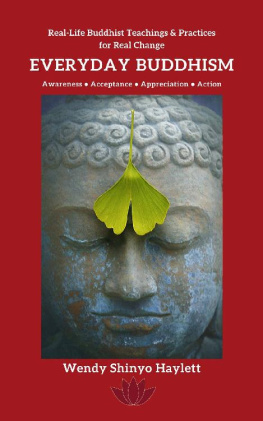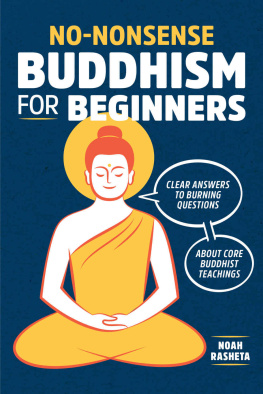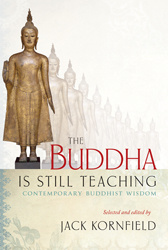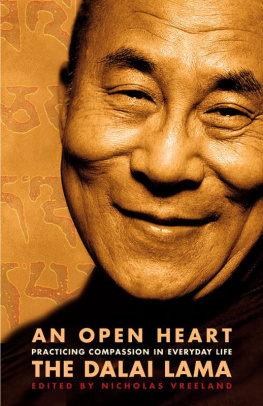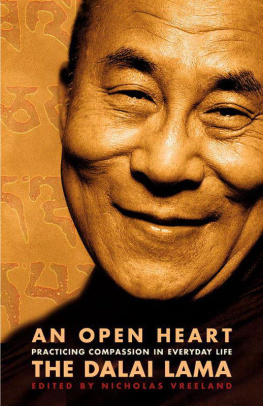EVERYDAY BUDDHISM
Real-Life Buddhist Teachings
& Practices for Real Change
***
Awareness * Acceptance
Appreciation * Action
Wendy Shinyo Haylett
Everyday Buddhism: Real-Life Buddhist Teachings & Practices for Real Change
2019 by Wendy Shinyo Haylett
All rights reserved. No part of this book may be reproduced in any form or by any electronic or mechanical means including information storage and retrieval systems, without permission in writing from the author. The only exception is by a reviewer, who may quote short excerpts in a review.
Cover designed by Wendy Shinyo Haylett
Visit the Everyday Buddhism website at:
www.everyday-buddhism.com
Printed in the United States of America
First Printing: November 2019
Cabin Publishing
Fairport, NY USA
ISBN-978-1-7341638-0-3
CONTENTS
TESTIMONIALS OF REAL CHANGE
I'm pretty sure you just changed my life. You said that your suffering can be a Buddha. I have been struggling and I can see how I can use this pain as a teacher, as a Buddha.MP
Ive been so inspired by your podcast. Ive struggled with the teachings in the past. The sentence structure of ancient texts is like trying to make sense of Shakespeare! Thank you for making these powerful tools accessible. GF
I wanted to tell you how thankful I am for your podcast. You have helped me to find peace within myself by studying the Dharma through your podcasts, as well as through other literary resources inspired by your teachings. DR
Podcast related theory and praxis so well. Effective, inspiring, empathetic. SE
I am beyond appreciative to have found your podcast! Your podcast feels like having a conversation with someone I can learn so much from. I needed this in my life and youve already helped bring a calm to the chaos I was feeling earlier today! S
Wendy makes Buddhist concepts relevant to the daily practice of life. She serves as a catalyst for personal growth and fulfillment. Thanks, Wendy for your insight and wisdom! MM
Sometimes when hip hop music and celebrity gossip turns into racket, I turn to Wendys podcast. Shes very humble and great at explaining terms and theories. Listening to a podcast a day keeps my mind interacting with those around me. KF
Love this. Super relatable content. I like the emphasis on how these concepts are hard, which is why we need to practice them. It feels helpful without being judgmental. F
Thank you for taking time to share your knowledge with such practical language and easy to follow explanations. Ive been studying Buddhism on and off for years, and your lessons are right up there with some of the best (i.e. Pema). :) RA
Wendy and Everyday Buddhism are a welcome addition to the plethora of podcast choices. Her teachings are smart and simple and relevant and real. BBM
DEDICATIONS
This book is dedicated to my precious teachers, from Gautama Buddha through the teachers who taught me in person or through books, from all schools: Theravada, Mahayana, and Vajrayana. May their aspirations for all beings to be free from suffering and have the causes for happiness be realized. May everyone be content and well, every day and everywhere!
I would like to acknowledge Frank and Gretchen Howard, my first in-person mentors; my first refuge Lama, Drupon Sonam Jorphel Rinpoche; and many other teachers (past and present) who have influenced me including H.E. Garchen Rinpoche, Khenpo Sherab Ozer, Thich Nhat Hanh, Taitetso Uno, Nobuo Haneda, David Brazier, Gregg Krech, John Tarrant, Stephen Batchelor, Clark Strand, Gary Snyder, Dgen, Shunryu Suzuki, Je Tsonghkapa, Master Shantideva, Shinran, Manshi Kiyozawa, and Shichi Maida.
A special bow of devotion to my Sensei, Rev. Koyo Kubose; his late father Rev. Gyomay Kubose; Adrienne Kubose Sensei; Rev. Albert Bloom and Haya Akegarasu; my Bright Dawn family of Senseis and lay ministry students; and the teacher and Buddha always at my side, my wife, Rene Seiyo Phillips.
SETTING THE TONE
Discarding all elements of supernaturalism and magical thinking, one returns to the mystery and tragedy of the everyday sublime. Instead of nirvana being located in a transcendent realm beyond the human condition, it would be restored to its rightful place at the heart of what it means each moment to be fully human. Rather than devoutly repeating what has been said many times before, you risk expressing your understanding in your own stammering voice.
Secular Buddhism: Imagining the Dharma in an Uncertain World
Stephen Batchelor
USING THE PRACTICE & REFLECTIONS SECTIONS
At the end of each chapter there are two sections, a practice and a reflection. Action means putting what youre learning into practice. Try doing the practices suggested at the end of each chapter to make the Dharma your own in your everyday life.
Reflection or meditation is part of that action. One teaching on how to be a student of the Dharma is to hear, think, and meditate on the teachings. This means going beyond just reading and to immersing yourself into the teachings. This immersion needs to go beyond mere words and concepts.
The reflection section is to help you pause and immerse yourself into a poem that can take you beyond rigid concepts and into the suchness of what the words in the preceding chapter were trying to express. It is through poetry that I have been able to express things exactly as they are. It is only in poetry that I can speak to you without the concepts words createstopping time, ending the separation between us, and uniting us in the immersion of suchness.
Yes, words are needed to write poetry, but the form of these words come from suchness itself, come from all life through me to you. As Shunryu Suzuki said when you do something, you should burn yourself completely, like a good bonfire, leaving no trace of yourself.
PREFACE
IN THIS BOOK AND THE PODCAST THAT SHARES ITS TITLE, my goal is to talk to everyday people about Buddhism in an everyday waythe way I wished people talked to me when I initially began studying it. There were some Buddhist teachers who wrote books and taught classes using concepts that a Western or American mind could easily graspand who minimized the use of complex terminology or Sanskrit and Pali wordsbut only a few.
I realize there were far more of those teachers in the 1990s when I started my search and study in earnest than in the 1950s, 1960s, and 1970s when the true pioneers of American Buddhism found their places as our teachers. And for that I am grateful. But it still took a hefty dose of dedication and persistence to make enough sense of the teachings to apply them in your everyday life.
To me, it seemed like trying to learn calculus when all I thought I needed was to do the math required to balance my bank account or create a simple business spreadsheet. Yet, in hindsight, the calculus (or big-picture understanding of continuous change) is necessary to effectively apply the simple math Buddhism offers to everyday life. And it isnt as complicated as it looks when you find a gentle guide to walk you deep into it. My stubborn personality and desire to learn made me a tenacious student willing to take that walk deep into the lists, cosmology, philosophy, and theology to get to the psychological core that makes Buddhism an invaluable practice for happiness.
And as I continued to learn, practice, and eventually become a Buddhist teacher and lay minister, I realized that despite a persons interest in Buddhism they were unlikely to apply the same time and effort required to make enough sense of the teachings to use in their livesespecially in the Internet age where the virtue of patience is declining in reverse correspondence to the quickness and availability of information.

